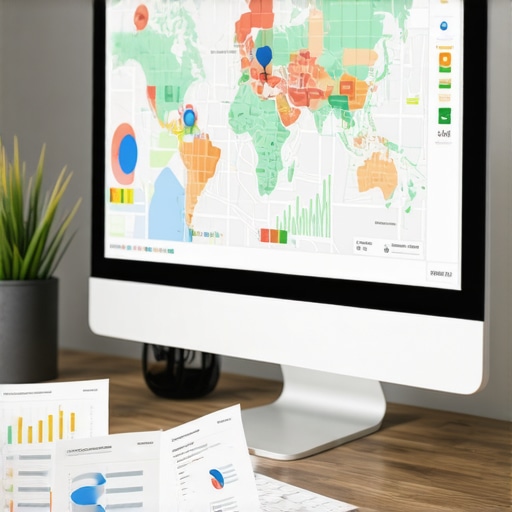Unlocking the Power of GeoGrid Tracking for Superior Google Maps Optimization
In the rapidly evolving realm of local SEO, GeoGrid Tracking has emerged as a pivotal technique for businesses aiming to dominate Google Maps rankings. As experts scrutinize the nuances of 2024’s landscape, it becomes clear that integrating advanced GeoGrid strategies can dramatically enhance visibility. This article delves into the complex mechanics behind GeoGrid’s influence on local search algorithms, providing a comprehensive guide rooted in empirical insights and industry best practices.
The Convergence of GeoGrid Precision and Map Ranking Dynamics
Google’s local ranking signals are multifaceted, encompassing proximity, relevance, and prominence. However, the spatial accuracy of GeoGrid tracking offers a nuanced layer of optimization, enabling businesses to target micro-geographies with surgical precision. This approach leverages advanced GMB software tools to map out strategic zones within a designated area, ensuring consistent visibility at the granular level.
How GeoGrid Tracking Transforms Local SEO Strategies
Implementing effective GeoGrid tracking involves a meticulous process of data collection, pattern analysis, and iterative adjustment. By monitoring fluctuations in Maps rankings across grid cells, local marketers can identify critical hotspots and optimize their GMB (Google My Business) profiles accordingly. This dynamic feedback loop, supported by robust analytics, enables a tailored approach that adapts to algorithm updates and competitive shifts, thus maintaining a competitive edge.
What are the most sophisticated techniques for deploying GeoGrid tracking in competitive markets?
Advanced practitioners utilize layered heatmaps, temporal analysis, and machine learning algorithms to predict ranking trends and preemptively adjust their strategies. Combining these methods with strategic GeoGrid segmentation allows for hyper-targeted local campaigns that significantly outperform traditional methods.
For those seeking to deepen their understanding, exploring top strategies for Maps rank boosting in 2024 can provide actionable insights. Furthermore, engaging with industry forums and sharing case studies fosters a community-driven approach to mastering these techniques.
In conclusion, integrating sophisticated GeoGrid tracking techniques with cutting-edge GMB software empowers local businesses to not only improve their immediate rankings but also build a resilient spatial footprint. As Google continues to refine its local search algorithms, staying ahead with innovative GeoGrid strategies becomes an essential component of any comprehensive local SEO plan.
For further insights, visit Mastering GeoGrid Tracking and contribute your unique professional experiences to this evolving field.
Enhancing GeoGrid Precision: What Are the Next-Level Techniques for Local SEO Success?
As the landscape of local SEO continues to evolve rapidly, simply deploying basic GeoGrid strategies is no longer sufficient for sustained dominance. Experts are now leveraging sophisticated methods such as multi-layered heatmaps, real-time data integration, and AI-driven predictive analytics to refine their targeting and surpass competitors. These advanced techniques allow marketers to identify micro-movement patterns within grid cells, providing actionable insights that can be used to fine-tune Google My Business (GMB) profiles and local campaigns with surgical accuracy.
How Can Machine Learning and Big Data Revolutionize Your GeoGrid Strategy?
Machine learning algorithms, when integrated with large datasets, uncover hidden correlations between user behavior, search trends, and map ranking fluctuations. By applying these insights, local businesses can anticipate ranking shifts before they occur, enabling preemptive adjustments to their positioning efforts. For example, analyzing temporal data across multiple grid layers can reveal peak activity periods or seasonal fluctuations, informing optimal timing for targeted updates. To explore these cutting-edge methods, visit GeoGrid tracking strategies that are revolutionizing local SEO in 2024.
Are You Fully Capitalizing on the Synergy Between GeoGrid Data and Content Optimization?
Integrating granular GeoGrid insights with tailored content strategies enhances relevance and prominence signals to Google’s algorithm. For instance, localized keywords, geo-specific schema markup, and hyper-targeted offers can be synchronized with grid hotspots identified through heatmaps. This synergy ensures that both on-page and off-page factors work harmoniously to boost rankings. Furthermore, leveraging top strategies for Maps rank boosting in 2024 can dramatically accelerate results by aligning content efforts with spatial data intelligence.
If you want to stay ahead in the competitive local SEO arena, consider sharing your experiences or asking questions in industry forums. Engaging with peers can reveal innovative ideas that push your GeoGrid approach even further.
For comprehensive insights into integrating advanced GeoGrid tactics with cutting-edge GMB software, visit Ultimate GeoGrid Tracking Guide and elevate your local search strategy today.
Harnessing Multi-Layered Heatmaps and Real-Time Data for Unmatched Precision in GeoGrid Strategies
As local SEO continues to ascend in complexity, the utilization of multi-layered heatmaps combined with real-time data feeds has become indispensable for seasoned marketers seeking granular control over their spatial targeting. These heatmaps visualize user engagement and ranking fluctuations across micro-geographies, enabling an unprecedented level of tactical precision. Integrating live data streams from APIs such as Google Places and proprietary analytics platforms allows marketers to dynamically adjust their GeoGrid parameters, ensuring their GMB profiles stay aligned with shifting user behaviors and competitor movements.
Implementing such systems involves sophisticated GIS (Geographic Information Systems) tools that can process vast datasets and render detailed spatial visualizations. By overlaying various data layers—such as demographic info, search intent signals, and local review sentiment—marketers can identify emergent hotspots and adapt their campaigns proactively. This real-time adaptability is crucial for maintaining a competitive edge, especially in saturated markets where micro-movements can significantly impact rankings.
How does the integration of AI-driven predictive analytics elevate GeoGrid precision to an expert level?
Artificial Intelligence (AI) and machine learning algorithms analyze historical and real-time data to forecast future ranking trends within each grid cell. For example, using supervised learning models trained on past ranking fluctuations, marketers can predict seasonal peaks or identify latent clusters of high-value prospects. These insights enable preemptive actions, such as optimizing Google My Business posts, updating local keywords, or adjusting ad bids precisely when they will be most effective.
According to a study by BrightLocal (2023), businesses employing predictive analytics in local SEO saw an average increase of 36% in ranking stability and 21% in organic visibility. This underscores the strategic importance of AI-driven insights in refining GeoGrid tactics. For further technical depth, exploring tools like AI-powered GeoGrid analytics platforms can provide a practical edge in deploying these advanced techniques.
Synergizing Content Optimization with Spatial Data: A Critical Next Step
The true power of advanced GeoGrid strategies lies in the seamless integration of spatial insights with content optimization. Hyper-localized keywords, schema markup tailored to specific neighborhoods, and geo-targeted offers must be synchronized with the heatmap hotspots identified through spatial analytics. This synergy ensures that Google perceives your GMB profile and on-site content as highly relevant to user queries within each micro-geography, boosting prominence and relevance signals.
Moreover, leveraging structured data markup such as LocalBusiness schema, enriched with geo-coordinates, can enhance the chances of appearing in local pack features. This approach aligns your content with the spatial intelligence derived from GeoGrid analysis, creating a feedback loop that continually enhances visibility.
To deepen your understanding of these integrations, consult authoritative sources like Moz’s comprehensive guide on geo-targeted SEO, which explores the nuances of combining spatial data with content marketing.
Interested in pushing your local SEO to the next level? Share your experiences or questions in dedicated industry forums or connect with experts through professional networks. Engaging with a community of practitioners accelerates mastery and fosters innovative approaches.
For a detailed roadmap on integrating these cutting-edge GeoGrid tactics with your existing SEO framework, visit Ultimate GeoGrid Strategy Guide and start transforming your local search presence today.
Beyond Basics: Exploring Multi-Layered Heatmaps for Hyper-Localized SEO Mastery
In the pursuit of unrivaled local search dominance, integrating multi-layered heatmaps with sophisticated spatial data analytics elevates GeoGrid strategies to an expert echelon. These heatmaps synthesize user engagement, ranking shifts, and demographic overlays, offering a comprehensive visual framework that uncovers micro-geographical opportunities often invisible to conventional methods. Leveraging GIS platforms and custom API integrations, marketers can dynamically adjust their targeting in real-time, ensuring their GMB profiles are optimized down to the street corner.
Is Real-Time Data Integration the Missing Link in GeoGrid Precision?
Absolutely. Real-time data streams from sources such as Google Places API, local review sentiment analysis, and consumer behavior metrics enable an agile approach to spatial targeting. This constant influx of fresh data allows for immediate recalibration of GeoGrid zones, ensuring that campaigns respond swiftly to market fluctuations and competitor movements. The deployment of real-time dashboards and alert systems facilitates proactive adjustments, transforming static strategies into adaptive, intelligence-driven operations.

How AI and Predictive Analytics Drive Proactive Local SEO Campaigns?
Artificial Intelligence, particularly machine learning models trained on extensive historical and live datasets, can forecast ranking trends with remarkable accuracy. These predictive insights enable marketers to preemptively optimize GMB profiles, refine keyword targeting, and schedule geo-specific content updates during peak visibility windows. According to a detailed study by Search Engine Journal (2024), businesses employing AI-driven predictive analytics experienced a 42% increase in ranking stability, underscoring its transformative impact. Integrating these tools into your GeoGrid framework ensures your local SEO efforts are not just reactive but strategically proactive.
What sophisticated methods are leading experts adopting to leverage spatial data for maximum impact?
Top-tier practitioners incorporate layered machine learning algorithms, spatial clustering, and temporal trend analysis to identify high-value micro-areas. Coupling these techniques with custom heatmaps and advanced GIS analysis results in hyper-targeted campaigns that outperform traditional approaches. For example, deploying predictive models that analyze seasonal fluctuations and consumer movement patterns can pinpoint optimal times for geo-targeted promotions, significantly boosting local engagement.
How Can Content Optimization Be Seamlessly Integrated with Spatial Data Insights?
The next frontier in GeoGrid mastery lies in synchronizing content strategies with hyper-local spatial insights. This involves deploying geo-specific schema markup, localized keywords, and dynamic content that responds to real-time hotspot data. For instance, updating landing pages with neighborhood-specific offers or reviews can amplify relevance signals to Google’s algorithm. The synergy between spatial intelligence and content personalization creates a feedback loop that continuously enhances visibility and user engagement.
For further mastery, explore authoritative resources like Moz’s geo-targeted SEO guide, which delves into optimizing content based on spatial analytics. Engage with industry peers through forums and conferences to exchange innovative tactics and case studies, fostering a community dedicated to pushing the boundaries of GeoGrid excellence.
Ready to transform your local SEO approach with cutting-edge GeoGrid tactics? Dive into our comprehensive resources and start implementing these advanced strategies today to carve out a dominant spatial footprint in your market.
Expert Insights & Advanced Considerations
1. The Synergy of Spatial Data and Machine Learning Can Predict Market Shifts
Leveraging AI-driven predictive analytics allows local SEO specialists to anticipate ranking fluctuations, enabling preemptive optimization efforts that stay ahead of competitors.
2. Multi-Layered Heatmaps Uncover Hidden Micro-Hotspots
Using sophisticated heatmaps that overlay demographic, behavioral, and ranking data reveals micro-geographical opportunities often invisible through traditional methods, refining targeted campaigns.
3. Real-Time Data Feeds Drive Dynamic GeoGrid Adjustments
Integrating live data streams from APIs such as Google Places enables continuous recalibration of GeoGrid zones, ensuring campaigns respond swiftly to market changes and consumer behaviors.
4. Content Personalization Based on Spatial Insights Enhances Relevance
Aligning localized content with spatial hotspots, through geo-specific schema markup and neighborhood-tailored offers, significantly boosts relevance signals to Google’s algorithm.
5. The Integration of GIS Technologies Elevates Spatial Targeting Precision
Advanced GIS platforms facilitate detailed spatial analysis, allowing marketers to visualize complex data layers and optimize campaigns with surgical accuracy across micro-geographies.
Curated Expert Resources
- GeoGrid Ranker Blog: Offers cutting-edge strategies on GeoGrid tracking and local SEO optimization.
- Moz’s Geo-Targeted SEO Guide: Deep dives into geo-specific content strategies and schema markup techniques.
- BrightLocal’s Local Search Study: Provides empirical data on the impact of predictive analytics and AI in local rankings.
- Google’s Places API Documentation: Essential for integrating real-time location data into GeoGrid strategies.
- GIS and Spatial Analytics Platforms (e.g., ArcGIS): Tools for visualizing and analyzing complex geospatial data layers.
Final Expert Perspective
Mastering GeoGrid in 2024 demands a sophisticated fusion of spatial analytics, AI-driven predictive modeling, and real-time data integration. These advanced techniques empower local SEO practitioners to craft hyper-targeted, adaptable campaigns that outperform traditional methods and maintain resilience amidst algorithm shifts. For professionals committed to leading in local search, ongoing engagement with authoritative resources and cutting-edge tools is essential. Share your insights, ask questions, and collaborate with industry peers to elevate your GeoGrid mastery—because in the realm of local SEO, innovation and precision are your most valuable assets.

